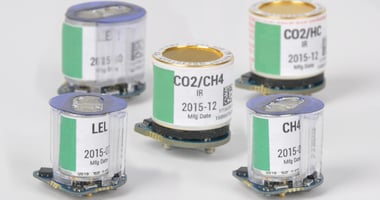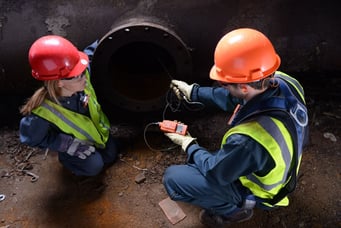An infrared (IR) lower explosive limits (LEL) sensor, as opposed to a catalytic bead, works based upon the absorption of infrared radiation at specific wavelengths as it passes through a volume of gas. While both an IR and catalytic bead LEL sensor are viable solutions for combustible gases, there are key differences that can make or break either sensor as a solution to fit your specific application with the Radius BZ1.
Benefits of an IR LEL Gas Sensor for Area Monitoring
Due to the nature of an IR LEL sensor, oxygen is not required for the sensor to detect combustible gases, making the IR LEL sensor ideal for sampling in inert environments, like lines that are being purged. Since there is no oxygen required, sampling can also be done without additional equipment like dilution tubes. Instead, simply attach the required length of tubing to your pumped Radius BZ1 and you can begin sampling.
IR LEL sensors are not damaged by high gas concentrations, so users can also continue to sample in high LEL environments for prolonged periods of time without damaging the IR LEL sensor. IR LEL sensors also are not susceptible to poisons and inhibitors that can damage catalytic bead LEL sensors. Many poisons and inhibitors are bi-products and gases commonly found in environments where gas detection is needed, so you can significantly increase your sensor longevity by choosing an IR LEL sensor.
IR LEL sensors also use less power than a standard catalytic bead sensor, allowing for longer monitor runtime. For example, a non-pumped Radius BZ1 using a catalytic bead LEL sensor can run for 7 days, while the same configuration with a methane IR LEL sensor in place of the catalytic bead can run for 9.5 days.
When to Avoid Using an IR LEL Gas Sensor for Area Monitoring
Although IR LEL sensors have several benefits over standard catalytic bead LEL sensors, they do have some drawbacks that may make them unsuitable for your application. The main drawback is that IR LEL sensors are blind to some gases, the most common being hydrogen (H2) and acetylene (C2H2). IR LEL sensors will not detect these gases, so if you have the potential for either to be present in your application, you should not use an IR LEL sensor.
IR sensors can also display false readings due to humidity, especially when moving from cold to warm atmospheres. While these false readings can be a nuisance, they are self-correcting. If readings appear when your Radius BZ1 is moved from a cold to warm and humid atmosphere, simply wait for the sensor to stabilize on its own.
Choosing the Right IR LEL Gas Sensor for Your Application
There are two types of IR LEL gas sensors available: Methane IR LEL and Hydrocarbon IR LEL. Both sensors measure from 0-100% LEL with a resolution of 1% LEL.
- Methane IR LEL Sensor: This sensor is optimized for detecting methane and natural gas. It is ideal for applications where the combustible gas is known to be methane. However, it has a non-linear response for other combustible gases, making it unsuitable for detecting a wide range of gases.
- Hydrocarbon IR LEL Sensor: This sensor offers a more linear response to multiple combustible gases when calibrated to propane. It is best suited for applications requiring detection of various combustible gases. By knowing the gas being detected, you can apply a correlation factor to calculate the actual concentration. Note that this sensor has limited response to methane.
To determine the best sensor for your specific application, consult a gas detection expert or explore more about the Radius BZ1 and IR LEL sensor options.



